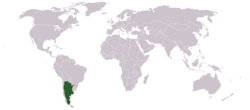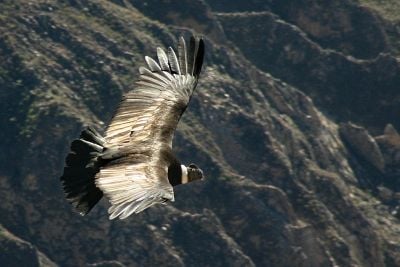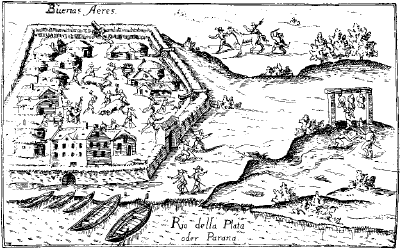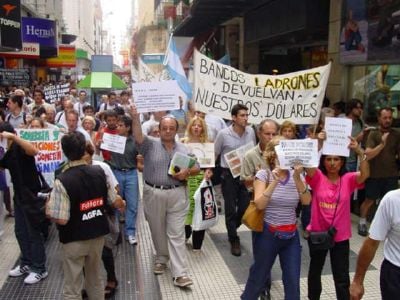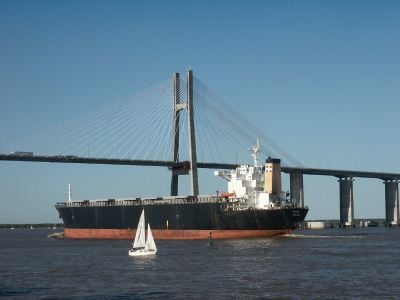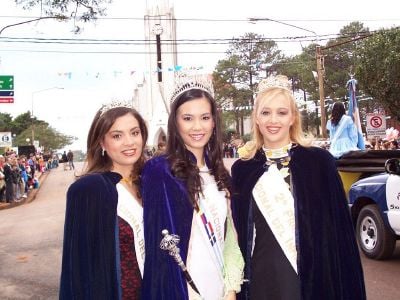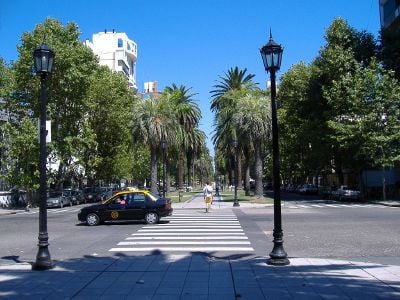Argentina
| Rep√ļblica Argentina¬†(Spanish) Argentine Republic |
||||||
|---|---|---|---|---|---|---|
|
||||||
| Motto: "En unión y libertad" (Spanish) "In Unity and Freedom" |
||||||
| Anthem: Himno Nacional Argentino |
||||||
| Capital (and largest city) | Buenos Aires 34¬į36‚Ä≤S 58¬į23‚Ä≤W | |||||
| Official languages | Spanish (de facto) | |||||
| Recognized regional languages | Araucano, Guaraní, Quechua,Welsh | |||||
| Ethnic groups (2010 est.) | 97.2% European (mostly Spanish and Italian descent) and Mestizo (mixed European and Amerindian ancestry) 2.4% Amerindian 0.4% African descent[1] |
|||||
| Demonym | Argentine, Argentinian | |||||
| Government | Federal presidential constitutional republic | |||||
|  -  | President | Javier Milei | ||||
|  -  | Vice President | Victoria Villarruel | ||||
|  -  | President of Supreme Court | Horacio Rosatti | ||||
| Legislature | Congress | |||||
|  -  | Upper House | Senate | ||||
|  -  | Lower House | Chamber of Deputies | ||||
| Independence | from Spain  | |||||
|  -  | May Revolution | May 25, 1810  | ||||
|  -  | Declared | July 9, 1816  | ||||
|  -  | Current constitution | May 1, 1853  | ||||
| Area | ||||||
|  -  | Total | 2,766,890 km² (8th) 1,068,302 sq mi  |
||||
|  -  | Water (%) | 1.1 | ||||
| Population | ||||||
|  -  | 2022 census | 47,327,407 [2] (31st) | ||||
|  -  | Density | 14.4/km² (178th) 37.3/sq mi |
||||
| GDP (PPP) | 2023 estimate | |||||
|  -  | Total | |||||
|  -  | Per capita | |||||
| GDP (nominal) | 2023 estimate | |||||
|  -  | Total | |||||
|  -  | Per capita | |||||
| Gini (2020) | 42.3[1] (high)  | |||||
| Currency | Peso ($) (ARS) |
|||||
| Time zone | ART (UTC-3) | |||||
| Internet TLD | .ar | |||||
| Calling code | [[++54]] | |||||
Argentina is the second-largest country in South America and the eighth-largest in the world. It occupies a continental surface area of 1,078,000 square miles (2,791,810 square kilometers) and is located between the Andes Mountains in the west and the South Atlantic Ocean in the east and south. It is bordered by Paraguay and Bolivia in the north, Brazil and Uruguay in the northeast, and Chile in the west and south. It also claims the British overseas territories of the Falkland Islands and South Georgia and the South Sandwich Islands. Under the name of Argentine Antarctica, it claims 374,312 square miles (969,464 square kilometers) of Antarctica, overlapping other claims by Chile and the United Kingdom.
Its name derives from the Latin argentum, meaning silver, and was based upon the legend of Sierra del Plata‚ÄĒa mountain range of silver‚ÄĒwhich reached Spain around 1524. It benefits from rich natural resources, a highly literate population, an export-oriented agricultural sector, and a diversified industrial base. Argentina is considered by many as South America‚Äôs leading Spanish-speaking nation, and its influence extends far beyond its borders, both culturally and politically. Together with Portuguese-speaking Brazil, it is the dominant economic power in South America.
The spiritual and philosophical foundations of Argentina are an extension of Spanish culture and civilization, centered on Catholicism, to which 80 percent of its population still adheres. Though the earliest settlers were from Spain and Italy, later immigrants arrived from France, Scandinavia, the United Kingdom and Ireland, and Eastern European nations such as Poland, Russia, Ukraine, as well as Balkan nations such as Croatia, Romania and Serbia. The Patagonian Chubut Valley has a significant Welsh-descended population. The majority of Argentina's Jewish community, the largest in Latin America and fifth-largest in the world, also derives from immigrants of Northern and Eastern European Ashkenazi Jews.
Origin and history of the name
The name Argentina derives from the Latin argentum, meaning silver. The first Spanish conquistadors discovered the R√≠o de la Plata ("River of Silver" or "River Plate"). Indigenous people gave gifts of silver to the survivors of the shipwrecked expedition, who were led by Juan Diaz de Solis. The legend of Sierra del Plata‚ÄĒa mountain range of silver‚ÄĒreached Spain around 1524. The source of the silver was the area where the city of Potos√≠, in current day Bolivia, was to be founded in 1546. An expedition that followed the trail of silver up the Paran√° and Pilcomayo rivers finally reached the source of the silver, only to find it already claimed by previous explorers that had reached it from Lima, the capital of the Viceroyalty of Peru.
The Portuguese cartographer Lopo Homem made reference to the place as Terra Argentea in a 1554 map.[4] The first mention of the name "Argentina" was in Mart√≠n del Barco Centenera's poem Argentina y conquista del R√≠o de la Plata, con otros acaecimientos de los reinos del Per√ļ, Tucum√°n y estado del Brasil, published in Spain in 1602,[5]
Ten years later, in 1612, Ruy Díaz de Guzmán published the book Historia del descubrimiento, población, y conquista del Río de la Plata (History of the discovery, population, and conquest of the Río de la Plata), naming the territory discovered by Solís Tierra Argentina ("Land of Silver", "Silvery Land").
Geography
Argentina is nearly 2,300 miles (3,700 km ) long from north to south, and 870 miles (1,400 km ) from east to west. It can roughly be divided into three parts: the fertile plains of the Pampas in the central part of the country, the center of Argentina's agricultural wealth; the flat to rolling plateau of Patagonia in the southern half down to Tierra del Fuego; and the rugged Andes Mountain range along the western border with Chile, with the highest point located in the province of Mendoza. Cerro Aconcagua, at 22,834 feet, is the Americas' highest mountain.
The plains west and south from Buenos Aires are among the most fertile in the world. The western part of La Pampa province and the San Luis province also have plains, but they are drier. The Gran Chaco region in the north of the country is semi-arid.
The steppes of Patagonia, in the provinces of Neuquen, Rio Negro, Chubut and Santa Cruz, are of tertiary origin. The first human settlement in this area dates back to the tenth century. The first European to reach this zone was Ferdinand Magellan and the first to traverse the Patagonian plain was Rodrigo de la Isla.
Major rivers include the Paraguay, Bermejo, Colorado, Uruguay and the largest river, the Paraná. The latter two flow together before meeting the Atlantic Ocean, forming the estuary of the Río de la Plata. The land between these both is called Mesopotamia.
The Argentine climate is predominantly temperate with extremes ranging from subtropical in the north to arid and sub-Antarctic in the far south.
Enclaves and exclaves
There is one Argentine exclave: the island of Martín García. It is near the confluence of the Paraná and Uruguay rivers, a half mile inside Uruguayan waters, about two miles from the Uruguayan coastline, near the small city of Martín Chico.
An agreement reached by Argentina and Uruguay in 1973 reaffirmed Argentine jurisdiction over the island, ending a century-old dispute between the two countries. According to the terms of the agreement, Martín García is to be devoted exclusively to a natural preserve. Its area is about 500 acres (2 square kilometers) and its population is about 200 people.
Climate
Because of longitudinal and elevation amplitudes, Argentina is subject to a variety of climates. As a rule, the climate is predominantly temperate with extremes ranging from subtropical in the north to subpolar in the far south. The north of the country is characterized by very hot, humid summers with mild drier winters, and is subject to periodic droughts. Central Argentina has hot summers with thunderstorms in the western section producing some of the world's largest hail), and cool winters. The southern regions have warm summers and cold winters with heavy snowfall, especially in mountainous zones. Higher elevations at all latitudes experience cooler conditions.
Flora and fauna
Subtropical plants dominate the north area known as the Gran Chaco region of South America. Aquatic plants thrive in the wetlands dotting the region.
In central Argentina the pampas are a true tallgrass prairie ecosystem. The original pampa had virtually no trees; today along roads or in towns and country estates, some imported species like the American sycamore or eucalyptus are present. The only tree-like plant native to the pampa is the omb√ļ, an evergreen. The surface soils of the pampa are a deep black color, primarily humus, known commonly as compost. It is this which makes the region one of the most agriculturally productive on earth.
Most of Patagonia in the south lies within a rain shade of the Andes. The plantlife, shrubby bushes and plants, is well suited to withstand dry conditions. The soil is hard and rocky making large-scale farming impossible except along river valleys. Coniferous forests grow in far western Patagonia and on the island of Tierra del Fuego. Other introduced trees present in forestry plantations include spruce, cypress, and pine. Common plants are the copihue and coihue.[6]
Along the many river oases, grasses and trees grow in significant numbers. The area presents optimal conditions for the large scale growth of grape vines. In the northwest of Argentina there are many species of cacti. In the highest elevations (often above 4,000 meters), no vegetation grows due to the extreme altitude, and the soils are virtually devoid of any plant life.
The ceibo flower, of the tree Erythrina crista-galli, is the national flower of Argentina.
The central grasslands are populated by the armadillo, pampas cat, and the rhea, a flightless bird. Hawks, falcons, herons, and partridges inhabit the region. There are also deer and fox. Some of these species extend into Patagonia.
The western mountains are home to different animals. These include the llama, guanaco, vicu√Īa, among the most recognizable species of South America. Also in this region are the jackal, Andean cat, and the largest flying bird in the New World, the condor.
Southern Argentina is home to the cougar, huemul, pud√ļ (the world's smallest deer), and wild boar. The coast of Patagonia is rich in animal life: elephant seals, fur seals, sea lions, and species of penguin. The far south is populated by cormorant birds.[6]
The territorial waters of Argentina have abundant ocean life; mammals such as dolphins, orcas, and whales like the southern right whale, a major tourist draw for naturalists. Sea fish include sardines, hake, dolphinfish, salmon, and shark; also present are squid and spider crab in Tierra del Fuego. Rivers and streams in Argentina have many species of trout and the South American Dourado dorado fish. Outstanding snake species include boa constrictor, and the very venomous pit viper and South American rattlesnake.
History
The first signs of human habitation in Argentina are located in Patagonia (Piedra Museo, Santa Cruz), and date from 11,000 B.C.E. Around 1 C.E., several corn-based civilizations developed in the western and northwestern Andean region (Ansilta, Condorhuasi, Ciénaga, Aguada, Santa María, Huarpes, Diaguitas, Sanavirones, among others). In 1480 the Inca Empire, under the rule of emperor Pachacutec, launched an offensive and conquered present-day northwestern Argentina, integrating it into a region called Collasuyu. In the northeastern area, the Guaraní developed a culture based on yucca and sweet potato. The central and southern areas (Pampas and Patagonia) were dominated by nomadic cultures, unified in the seventeenth century by the Mapuches.
The first Europeans arrived in 1502. Spain established a permanent colony on the site of present-day Buenos Aires in 1580, and the Viceroyalty of the Río de la Plata in 1776. In 1806 and 1807 the British Empire invaded the Viceroyalty, but the Creole population managed to repel the invasions. On May 25, 1810, following the confirmation of rumors about the overthrow of King Ferdinand VII by Napoleon, the most prominent citizens of Buenos Aires took advantage of the situation and created the First Government Junta. Independence from Spain was declared on July 9, 1816. As in other South American countries, Argentina faced a conflict between centralist and federalist forms of government. Centralist and federationist groups were in conflict until national unity was established and the constitution promulgated in 1853.
Foreign investment and immigration from Europe led to the adoption of modern agricultural techniques and integration of Argentina into the world economy in the late nineteenth century. In the 1880s, the "Conquest of the Desert" subdued or exterminated the remaining indigenous tribes throughout the southern Pampas and Patagonia.
From 1880 to 1930, Argentina enjoyed increasing prosperity and prominence. Conservative forces dominated Argentine politics until 1916, when their traditional rivals, the Radical Civic Union, won control of the government. The military forced Hipólito Yrigoyen from power in 1930, leading to another decade of conservative rule.
Era of Juan Peron

In 1943 a clique of military plotters overthrew the ineffective civilian government. The military regimes of the following three years came increasingly under the influence of then Col. Juan Perón. Perón rose to power while a series of generals served as president. As minister of labor, he strengthened the unions, winning the support of urban workers by giving them higher wages, more paid holidays, and other benefits. After a campaign marked by repression of the liberal opposition by the federal police and by strong-arm squads, Perón was elected president in February 1946 with 56 percent of the popular vote.
Perón sought to continue his policies of empowering the working class and greatly expanded the number of unionized workers. The government nationalized the country's industries and discouraged foreign investment. It raised money to try to strengthen manufacturing industries rapidly by taxing farm products. As a result, farm production dropped, and the nation's income fell. But wages continued to rise. Peron suspended freedom of the press and freedom of speech. He had Argentina's Constitution changed to increase his powers and allow him a second term of office.
Peron's power declined during his second term, which began in 1952. He had already made many enemies. Finally, he lost the support of the Roman Catholic Church, after limiting its authority. In 1955, the army and navy revolted, and Peron fled the country. He eventually went into exile in Spain. The "Revolución Libertadora" of 1955 deposed him.
From the 1950s to 1970s, military and civilian administrations traded power. In those years the economy grew strongly and poverty declined (less than 6 percent in 1975) while political violence continued escalating. In 1973, Perón returned to the presidency, but he died less than a year after. His third wife Isabel, the Vice President, succeeded him in office, but a military coup removed her from office on March 24, 1976.
Last half of twentieth century
The armed forces took power through a junta in charge of the self-appointed National Reorganization Process from 1976 until 1983. The armed forces repressed opposition using harsh illegal measures known as the "Dirty War" during which thousands of dissidents disappeared, while Argentine intelligence (SIDE) cooperated with the Chilean secret police (DINA) and other South American intelligence agencies, and allegedly with the U.S. Central Intelligence Agency in "Operation Condor." Many of the military leaders that took part in the Dirty War were trained in the School of the Americas, among them Argentine dictators Leopoldo Galtieri and Roberto Viola.
Economic problems, charges of corruption, public revulsion in the face of human rights abuses and, finally, the country's 1982 defeat by the British in the Falklands War discredited the Argentine military regime.
Democracy was restored in 1983. Ra√ļl Alfons√≠n's Radical party government took steps to account for the "disappeared," established civilian control of the armed forces, and consolidated democratic institutions. The members of the three military juntas were prosecuted and sentenced to life terms. However, failure to resolve endemic economic problems and an inability to maintain public confidence led to Alfons√≠n's early departure.
President Carlos Menem imposed a peso‚ÄĒdollar fixed exchange rate in 1991 to stop hyperinflation and adopted far-reaching market-based policies, dismantling protectionist barriers and business regulations, and implementing a privatization program. These reforms contributed to significant increases in investment and growth with stable prices through most of the 1990s.
Twenty-first century
The Menem and de la R√ļa administrations faced a diminishing competitiveness of exports, massive imports which damaged the nation's industries and increased unemployment, chronic fiscal and trade deficits, and the contagion of several economic crises. The Asian financial crisis in 1998 precipitated an outflow of capital that mushroomed into a recession, which led to a total freeze of bank accounts (the corralito), and culminated in a financial panic in November 2001. The next month, amid bloody riots, President de la R√ļa resigned.
In the two weeks following, several new presidents followed in quick succession, culminating in Eduardo Duhalde being appointed interim president by the Legislative Assembly on January 2, 2002. Argentina defaulted on its international debt obligations. The peso's almost 11-year-old linkage to the U.S. dollar was abandoned, resulting in major depreciation of the peso and inflation, in turn triggering a jump in unemployment and poverty. Although it was one of Argentina's worst crises ever, a military coup did not materialize and democracy remained in place.
With a more competitive and flexible exchange rate, the country began implementing new policies based on re-industrialization, import substitution, increased exports, and consistent fiscal surplus. By the end of 2002, the economy began to stabilize. In 2003, Néstor Kirchner was elected president. During Kirchner's presidency, Argentina restructured its defaulted debt with a steep discount (about 70 percent) on most bonds, renegotiated contracts with utilities, and nationalized previously privatized industries.[7]
Argentina enjoyed a short period of economic growth. However, despite economic gains and increased renewable energy production and subsidies, the overall economy became sluggish from 2011.
In 2007, Cristina Fernández de Kirchner, wife of Néstor, was elected president, becoming the first woman elected as president of Argentina. She was subsequently reelected in 2011. Fernández de Kirchner's administration established positive foreign relations with countries with questionable human rights records, including Venezuela, Iran, and Cuba, while at the same time relations with the United States and the United Kingdom became increasingly strained.
In 2015, center-right coalition candidate Mauricio Macri became the first democratically elected non-peronist president since 1916 that managed to complete his term in office without being overthrown. He took office on December 10, 2015 but under Macri's administration economic recovery remained elusive. President Alberto Fern√°ndez and Vice President Cristina Fern√°ndez de Kirchner took office in December 2019. In April 2023, President Alberto Fernandez announced that he woulf not seek re-election. The November 2023 election ended in a win for libertarian outsider Javier Milei, who was sworn in as the new president on December 10, 2023.
Government
Argentina's political framework is a federal presidential representative democratic republic, in which the President of Argentina is both head of state and head of government, complemented by a pluriform multi-party system.
The Argentine Constitution of 1853 mandates a separation of powers into executive, legislative, and judicial branches at the national and provincial level.
Executive power resides in the President and his/her cabinet. The President and Vice President are directly elected to four-year terms, limited to two consecutive terms, and cabinet ministers are appointed by the President.
Legislative power is vested in the bicameral National Congress or Congreso de la Nación, consisting of a Senate of 72 seats, and a Chamber of Deputies of 257 members. Senators serve six-year terms, with one-third standing for reelection every two years. Members of the Chamber of Deputies are directly elected to four-year terms via a system of proportional representation, with half of the members of the lower house being elected every two years. It is required that a third of the candidates presented by the parties must be women.
The judiciary is independent of the executive and the legislature. The Argentine Supreme Court of Justice has nine members who are appointed by the President in consultation with the Senate. The rest of the judges are appointed by the Council of Magistrates of the Nation, a secretariat composed of representatives of judges, lawyers, the Congress, and the executive.
Argentina also belongs to Mercosur, an international trading bloc which has some supranational legislative functions. Mercosur is composed of five full members: Argentina, Brazil, Paraguay, Uruguay, and Venezuela. Mercosur also has five associate members without full voting rights: Bolivia, Chile, Colombia, Ecuador, and Peru.
Administrative divisions
Argentina is divided into 23 provinces and one autonomous city, Buenos Aires, commonly known as capital federal. Provinces are divided into smaller secondary units called departments, of which there are 376. The province of Buenos Aires has 134 similar divisions known as partidos. Departments and partidos are further subdivided into municipalities or districts.
Buenos Aires has been the capital of Argentina since its unification, but there have been projects to move the administrative center elsewhere. During the presidency of Ra√ļl Alfons√≠n a law was passed ordering the transfer of the federal capital to Viedma, a city in the Patagonian province of R√≠o Negro. Studies were underway in 1989 when hyperinflation killed the project. Though the law was never formally repealed, it has become a virtual historical relic, and the project all but forgotten.
Foreign Relations
Argentina was the only Latin American country to participate in the 1991 Gulf War under mandate of the United Nations and in every phase of the Haiti operation. It has also contributed to worldwide peacekeeping operations, including in El Salvador-Honduras-Nicaragua, Guatemala, Ecuador-Peru, Western Sahara, Angola, Kuwait, Cyprus, Croatia, Kosovo, Bosnia and East Timor. In recognition of its contributions to international security and peacekeeping, U.S. President Bill Clinton designated Argentina as a major non-NATO ally in January 1998. In 2005, it was elected as a temporary member of the UN Security Council.
Argentina emphasizes Mercosur (Southern Common Market) as its first external priority, in contrast to a reliance on its previous relationship with the United States during the 1990s.
Argentina claims sovereignty over the Falkland/Malvinas Islands, the South Shetland Islands, the South Sandwich Islands and almost one million km¬≤ in Antarctica, between the 25¬į W and the 74¬į W meridians and the 60¬į S parallel. This Antarctic sector is called Argentine Antarctica and is considered an integral part of the national territory for many reasons, including more than one century of permanent occupation.
Military
Argentina's armed forces are controlled by the Defense Ministry, with the country's President as their Commander-in-Chief. Historically, Argentina's military has been one of the best equipped in the region (for example, developing its own advanced jet fighters as early as the 1950s),[8] but has faced expenditure cutbacks in comparison to other regional militaries. The age of allowable military service is 18 years; there is no obligatory military service and currently no conscription.
The military is composed of a traditional army, navy and air force. Controlled by a separate ministry (the Interior Ministry), Argentine territorial waters are patrolled by the Naval Prefecture, and the border regions by the National Gendarmerie; both branches however, maintain liaisons with the Defense Ministry. As of early 2007, Argentina's Armed Forces were performing major operations in Haiti and Cyprus, in accordance to specified UN mandates.
Economy
Argentina is one of the most developed countries in Latin America. It boasts the highest GDP per capita, the highest levels of education measured by university attendance, and a reasonable infrastructure that in many aspects is equal in quality to that found in fully industrialized nations. Telecommunications are particularly strong, with an important penetration of mobile telephony, Internet, and broadband services.
Argentina benefits from rich natural resources, a highly literate population, an export-oriented agricultural sector, and a diversified industrial base. Argentina is the largest producer in the world of yerba mate (due to the large domestic consumption of mate), and in the top ten largest producers in the world of soybeans, maize, sunflower seed, lemons, pears, barley, grapes, artichokes, tobacco, and cotton. It is also a notable producer of wine and exporter of beef, honey, and wool.
The country has historically had a large middle class, in contrast to other Latin American countries, but this segment of the population was decimated by a succession of economic crises. Today, while a significant segment of the population is still financially well-off, they stand in sharp contrast with millions who live in poverty or on the brink of it.
Demographics
Unlike many of its neighboring countries, Argentina's population descends mostly from Europeans of Spanish, Italian, and other European descent, with a large proportion of the population having at least one indigenous ancestor.
After the regimented Spanish colonists, waves of immigrants from European countries arrived in the country throughout the late nineteenth and early twentieth centuries. Contributors include France (mostly to Buenos Aires), Scandinavia (especially Sweden), the United Kingdom and Ireland (Buenos Aires and Patagonia), and Eastern European nations such as Poland, Russia, Ukraine, as well as Balkan nations (especially Croatia, Romania and Serbia). The Patagonian Chubut Valley has a significant Welsh-descended population. The majority of Argentina's Jewish community, the largest in Latin America and the fifth-largest in the world, also derives from immigrants of Northern and Eastern European Ashkenazi Jews.
The largest ethnic minority is the mestizo population in the northern provinces. Since population censuses in Argentina do not take into account mixed-race people as non-white, it is difficult to determine their real size. Estimates range from 3 percent to 15 percent, the latter figure being the most credited.
Small numbers of people from East Asia have also settled Argentina, mainly in Buenos Aires. The first Asian-Argentines were of Japanese descent, but Koreans, Vietnamese, and Chinese soon followed. There are also smaller numbers of people from the Indian subcontinent.
In recent decades, especially during the 1990s, there has been a substantial influx of immigrants from neighboring South American countries, mainly from Paraguay, Bolivia, Peru, and Chile.
Argentina also has a large Arab community, made up of immigrants from Syria and Lebanon.
Urbanization
About 2.7 million people live in the autonomous city of Buenos Aires, and roughly 11.5 million in Greater Buenos Aires, making it one of the largest urban conglomerates in the world. Together with their respective metropolitan areas, the second- and third-largest cities in Argentina, Córdoba and Rosario, comprise about 1.3 and 1.1 million inhabitants, respectively.
Most European immigrants to Argentina, who came in great waves especially around World War I and World War II, settled in the cities, which offered jobs, education, and other opportunities that enabled newcomers to enter the middle class. Since the 1930s, many rural workers have moved to the big cities.
In descending order by number of inhabitants, the major cities in Argentina are Buenos Aires, Córdoba, Rosario, Mendoza, Resistencia, La Plata, Tucumán, Mar del Plata], Salta, Santa Fe, and Bahía Blanca.
The 1990s saw many rural towns become ghost towns when train services were abandoned, and local products manufactured on a small scale were replaced by massive amounts of cheap imported goods. This was due in part to the government's monetary policy which kept the U.S. dollar exchange rate fixed and low. Many slums sprouted in the outskirts of the largest cities. They were inhabited by impoverished lower class urban dwellers, migrants from smaller towns in the interior of the country, and a great number of immigrants from neighboring countries that came during the time of dollar convertibility and did not leave after the 2001 crisis.
Argentina's urban areas have a European look, reflecting the influence of their European settlers. Many towns and cities are built like Spanish cities around a main square called a plaza. A cathedral and important government buildings often face the plaza. The general layout of the cities is called a damero, or checkerboard, since it is based on a pattern of square blocks, though modern developments sometimes depart from it.
Culture
Argentine culture has been primarily formed and influenced by its European roots. Buenos Aires is undeniably the most European city in South America and considered by many its cultural capital, due both to the prevalence of people of European descent and to conscious imitation.
Argentina has a rich history of world-renowned literature, including one of twentieth century's most critically acclaimed writers, Jorge Luis Borges.
Religion
Argentina is an overwhelmingly Christian country. The majority of Argentina's population is at least nominally Roman Catholic. Roman Catholicism is supported by the state and endorsed in the Constitution. Evangelical churches have gained a foothold in Argentina since the 1980s, including members of the Mormon Church.
The country also hosts a fairly large Jewish population. It is also home to one of the largest mosques in Latin America, serving Argentina's small Muslim community.
Music
Argentine culture is exemplified by its music and dance, particularly tango. To foreigners, tango refers to a particular dance, but the music together with the lyrics (often sung in a kind of slang called lunfardo) are what most Argentines primarily mean by tango. In modern Argentina, tango music is enjoyed by itself, particularly since the radical √Āstor Piazzolla redefined the music of Carlos Gardel.
Since the 1970s, rock and roll has been widely popular in Argentina. Rock and roll and pop music have experienced periodic bursts of popularity, with many new bands and composers becoming important icons of national culture. Argentine rock is the most listened-to music among youth.
Buenos Aires is considered the techno and electronica capital of Latin America, and hosts a variety of events including local raves, the South American Music Conference, and Creamfields (which has the world record of 65,000 people).
European classical music is well-represented in Argentina. Buenos Aires is home to the world-renowned Colón Theater. Classical musicians, such as Martha Argerich and Daniel Barenboim, and classical composers like Alberto Ginastera have become internationally famous.
Language
The only national official language of Argentina is Spanish, though the Amerindian language Guaraní also holds official status in the province of Corrientes.
Some immigrants and indigenous communities have retained their original languages in specific points of the country. For example, Patagonia has many Welsh-speaking towns, and there are a number of German-speaking cities in Córdoba, Buenos Aires and again in Patagonia. Italian, English and French are widely spoken, and other languages such as Japanese, Chinese, Korean and Russian are easily found in Buenos Aires, where the main immigrant communities are found.
Argentina is the largest Spanish-speaking community in the world that employs voseo (the use of the pronoun vos instead of t√ļ, associated with some alternate verb conjugations). The most prevalent dialect is Rioplatense, with most speakers located in the basin of the R√≠o de la Plata.
A phonetic study conducted by the Laboratory for Sensory Investigations of CONICET and the University of Toronto showed that the accent of the inhabitants of Buenos Aires (known locally as Porte√Īos) is closer to the Neapolitan Italian dialect than any other spoken language, which can be traced to the influx of Italian immigrants to the port city. This immigration had a profound influence on Lunfardo, the slang spoken in Buenos Aires and the R√≠o de la Plata, which has since permeated popular vocabulary in the region.
Cuisine
Argentine food is influenced by cuisine from Spain, Italy, Germany, France and other European countries. Argentina has a wide variety of staple foods, which include empanadas, a stuffed pastry; locro, a mixture of corn, beans, meat, bacon, onion, and gourd; and chorizo, a meat-based spicy sausage. The Argentine barbecue, asado, is one of the most famous in the world and includes various types of meats, including chorizo, sweetbread, chitterlings, and blood sausage. Beef tends to be a dominant main course in many Argentine meals; Argentines have the highest consumption of red meat in the world. A common custom among Argentines is drinking Yerba Mate.
Sport
Pato is the national sport, an ancient horseback game locally originated in the early 1600s and predecessor of horseball.
The most popular sport is football (soccer). Along with Brazil and France, the men's national team is the only one to have won the most important international triplet: World Cup, Confederations Cup, and the Olympic Gold Medal. It has also won 15 Copas América, 7 Pan American Gold Medals and many other trophies. Diego Maradona and Lionel Messi are among the best players in the game's history.
Other popular and internationally successful sports include field hockey, basketball, rugby, boxing, tennis, polo, and auto racing.
Public holidays
Argentines commemorate a number of historical events, such as the May Revolution (May 25), Independence Day (July 9), Malvinas Day (April 2) and Memorial Day (March 24), the start of the dictatorship of the Proceso). They also celebrate National Flag Day (June 20) through its creator, Manuel Belgrano, and Teachers' Day (September 11) with an homage to Domingo Faustino Sarmiento. The Liberator José de San Martín is honored on August 17. Historical figures like San Martín, Belgrano and Sarmiento are remembered on the anniversary of their deaths, rather than their births.
Argentina also celebrates international holidays such as Labor Day and Columbus Day, and several Catholic holidays including Christmas, Feast of the Immaculate Conception and Easter.
Notes
- ‚ÜĎ 1.0 1.1 CIA, Argentina The World Factbook. Retrieved January 3, 2024.
- ‚ÜĎ Hay m√°s de 47 millones de argentinos, seg√ļn el Censo-2022 Infobae, May 19, 2022. Retrieved January 3, 2024.
- ‚ÜĎ 3.0 3.1 3.2 3.3 World Economic Outlook Database, October 2023 Edition. (Argentina) International Monetary Fund. Retrieved January 3, 2024.
- ‚ÜĎ Origen del Nombre: ¬ŅPor qu√© Argentina? Datos Rep√ļblica Argentina. Retrieved January 4, 2024.
- ‚ÜĎ El nombre de Argentina Retrieved January 4, 2024.
- ‚ÜĎ 6.0 6.1 Argentina: Plants and animals The World of Info. Retrieved January 4, 2024.
- ‚ÜĎ Carlos A. Floria and C√©sar A. Garc√≠a Belsunce, Historia de los Argentinos (Kapelusz, 1971).
- ‚ÜĎ Martin Waligorski,Pulqui: Argentina's Jet Adventure IPMS Stockholm Magazine, June 2002. Retrieved January 4, 2024.
ReferencesISBN links support NWE through referral fees
- Crooker, Richard A. Argentina. Philadelphia: Chelsea House Publishers, 2004. ISBN 0791074803
- Floria, Carlos A., and César A. García Belsunce. Historia de los Argentinos. Kapelusz, 1971.
- Frank, Nicole. Argentina. Wisconsin: Gareth Stevens Publisher, 2000. ISBN 083682315X
- Gofen, Ethel, and Leslie Jermyn. Argentina. New York: Benchmark Books, 2002. ISBN 0761413588
- Rodríguez, Julia. Civilizing Argentina: science, medicine, and the modern state. Chapel Hill, NC: University of North Carolina Press, 2006. ISBN 0807829978
External links
All links retrieved January 3, 2024.
- Argentina CIA World Factbook
- (Spanish) Argentine Provinces, Todo Argentina
- (Spanish) Senado de la Nación, Senate of Argentina
- (Spanish) Cámara de Diputados de la Nación, Chamber of Deputies of Argentina
- (Spanish) Turismo y Deportes, Tourism and Sports
- (Spanish) Telam
- (Spanish) Clarín
- (Spanish) Diario de Cuyo
- (Spanish) El Liberal
- (Spanish) La Capital
- (Spanish) Diario UNO
- (Spanish) Diario Los Andes
- (Spanish) La Nación
- (Spanish) La Nueva
- (Spanish) P√°gina/12
- (Spanish) La Voz del Pueblo
Argentina · Bolivia · Brazil · Chile · Colombia · Ecuador · Guyana · Panama* · Paraguay · Peru · Suriname · Trinidad and Tobago* · Uruguay · Venezuela
Dependencies
Aruba* (Netherlands) ·
Falkland Islands (UK) ·
French Guiana (France) ·
Netherlands Antilles* (Netherlands) ·
South Georgia and the South Sandwich Islands (UK)
* Territories also in or commonly reckoned elsewhere in the Americas (North America).
Credits
New World Encyclopedia writers and editors rewrote and completed the Wikipedia article in accordance with New World Encyclopedia standards. This article abides by terms of the Creative Commons CC-by-sa 3.0 License (CC-by-sa), which may be used and disseminated with proper attribution. Credit is due under the terms of this license that can reference both the New World Encyclopedia contributors and the selfless volunteer contributors of the Wikimedia Foundation. To cite this article click here for a list of acceptable citing formats.The history of earlier contributions by wikipedians is accessible to researchers here:
The history of this article since it was imported to New World Encyclopedia:
Note: Some restrictions may apply to use of individual images which are separately licensed.


